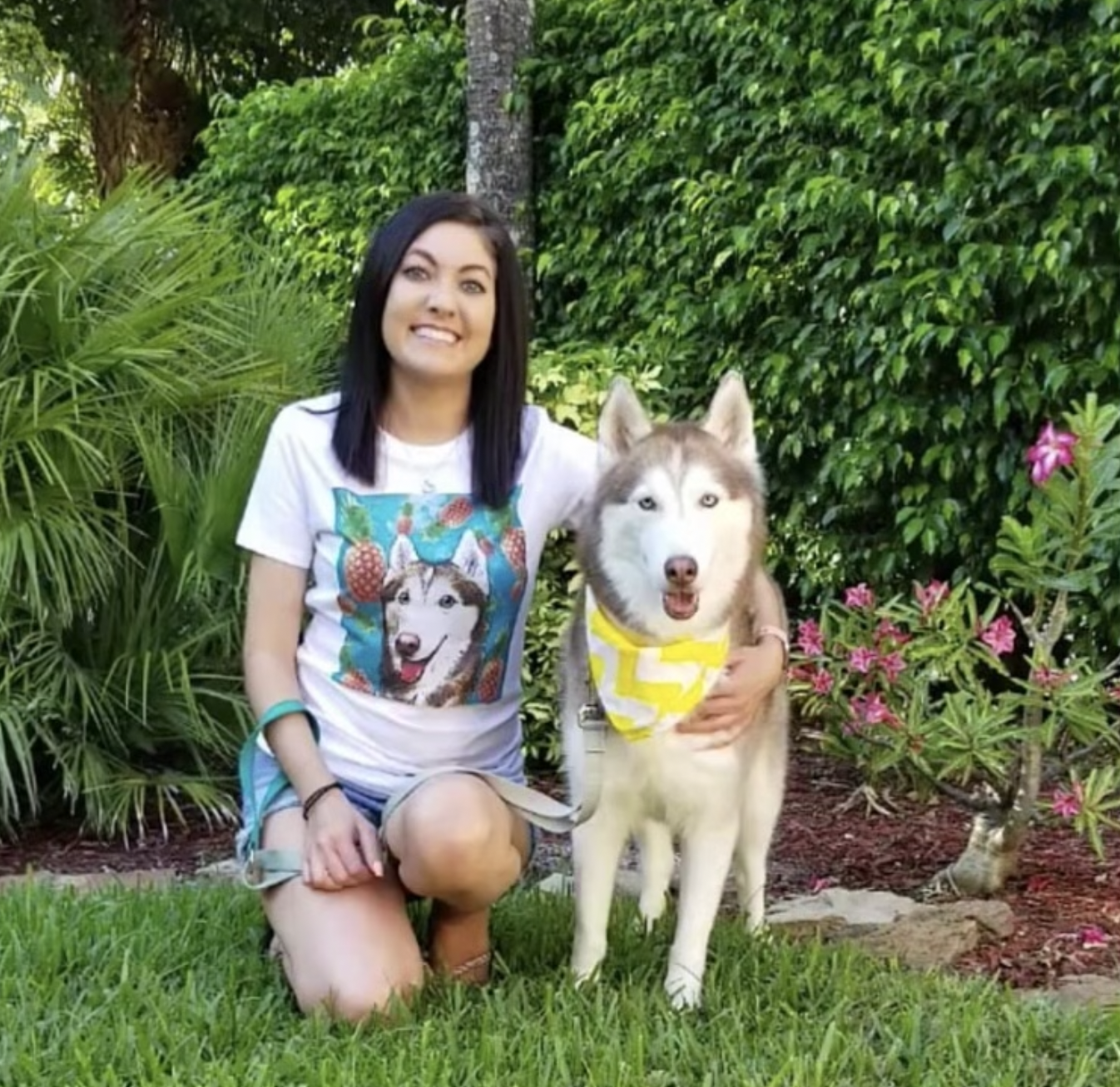Dogs have been keeping a huge secret from us! This entire time our pups actually have been able to talk to us! We just keep making the mistake of expecting them to learn our languages when we should be learning their language—a.k.a dog body language.
How Do Dogs Communicate?
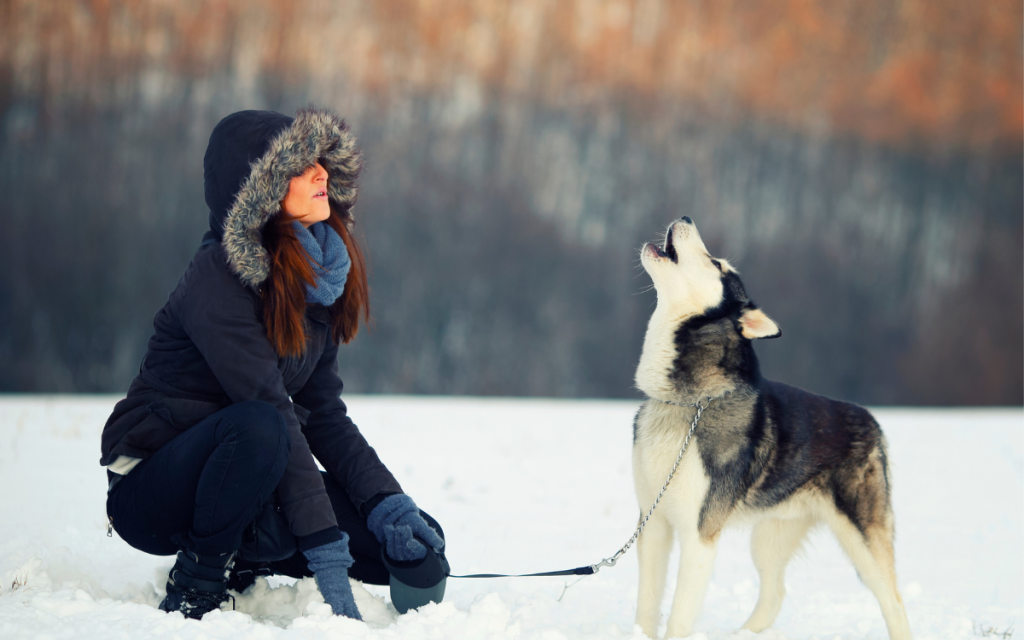

As much as you probably wish your dog could just talk to you and tell you about their day, or finally explain to you what they’re staring at down the hallway (seriously, is it a ghost!?), that’s unfortunately not how dogs communicate. If you’re paying attention, though, they’re telling you a whole lot more than you may realize! Dogs communicate in a few different ways, using:
- Vocals: Barks, growls, howls, whines, whimpers1.
- Body Language: Body posture, facial expressions, and tail wags1.
- Scent: Pheromones, urine marking, butt sniffing, and ground scratching used to communicate with other dogs and animals1. The importance of communicating through smell is still not yet fully understood by humans.
Note: This article focuses only on domesticated pet dogs. Wolves and stray dogs often have slightly different social structures and body language1.
Why Is It Important To Understand Your Dog’s Body Language?
One of the most important ways your dog will try to communicate with you and tell you how they feel is through their body language (body posture, facial expressions and tail wags). Those goofy head tilts, radar-like ear swivels, and silly butt wiggles—along with other body posture and vocals—can help clue you in to how your pup is feeling, and what their intentions are in different situations. Learning the basics of dog body language and “doggie culture” not only makes you look like a dog whisperer extraordinaire in front of your friends, but it helps you become a better pet parent in general by:
- Better understanding your dog’s emotions and intentions.
- Recognizing warning signs of stress, anxiety, fear, or aggression2.
- Reducing incidents of dog bites or attacks2.
- Strengthening bonds with your pup2.
- Learning how to navigate situations and predict future behaviors2.
- Avoiding miscommunications and misunderstandings2.
How To Read Your Dog’s Body Language
There’s one golden rule you need to follow when it comes to dog body language: Always look at a dog’s entire body and what it’s telling you—don’t just look at one body part! Think of each body part like a piece of a puzzle—you need to put each piece together to be able to see the picture clearly. Without all the pieces, you’re more likely to misinterpret the emotion your dog is showing you, which can lead to mishandling of a situation or exacerbation of negative behaviors.
Another thing to keep in mind: pay attention to your dog’s body language when they’re acting normally and doing routine things, like playing, eating, or walking around the house. This way, you get to know what your dog’s body language looks like, and can better tell when something is out of the ordinary.
You can be on your way to becoming a doggie mind reader by following these basic rules of dog body language:
- Consider The Situation: Is your dog somewhere they feel comfortable and with someone they know? Or are they somewhere new with a new person? Dogs are more likely to feel stress or fear around new situations and new people.
- Check Overall Body Posture: Is your dog tense or relaxed? Are they standing tall, or lowering their body to the ground? How your dog holds their body and shifts their weight tells a lot about how they feel.
- Look At Facial Expressions: What is your dog doing with their ears, eyes, mouth, teeth, and head?
- Watch Tail wags: Look at the location of your dog’s tail (high or low), the speed of the wag, and breadth of the wag. Dogs wag their tails at different speeds and amplitude to express different emotions.
- Listen For Vocals: Is your dog quiet, or are they barking, howling, growling or whimpering?
Respect Your Dog’s Boundaries!
This is so important that we’re giving it its own section. You need to respect your dog’s boundaries when they’re giving clear indicators that they’re not comfortable! For example, don’t force your dog to take dozens of selfies with you if you notice they keep holding their ears back and pulling away from hugs. Many dogs feel uncomfortable with hugging. Don’t let kids chase after your dog, pull on their body parts or climb on them ever, but especially when they’re holding their ears back, hunkering down, running away, or growling. Dogs deserve the chance to be heard when they say they’re uncomfortable! And don’t force your dog to meet (be petted by, sniff the hand of, or take a treat from) people they are not willingly/voluntarily approaching. It will not make them okay with the new person. It will make it worse.
Body Posture
The body postures we talk about in this section are the first piece of the body language puzzle. We’ll go into more detail about facial expressions and tail wags in sections below.
The way your dog holds their body can tell you a lot about how they’re feeling in a situation, and can even help you predict how they’ll act during an interaction2. For example, if your dog is showing signs of anxiety at the vet, you can take steps to help them feel more calm. Another example would be if your dog is showing signs of aggression around another dog, you can take steps to separate the dogs before things escalate if it’s an isolated incident, or you may decide to sign your dog up with a trainer if you see a pattern of aggressive body language.
Want even more doggie details? Check out this video on dog body language.
Relaxed/Happy Posture
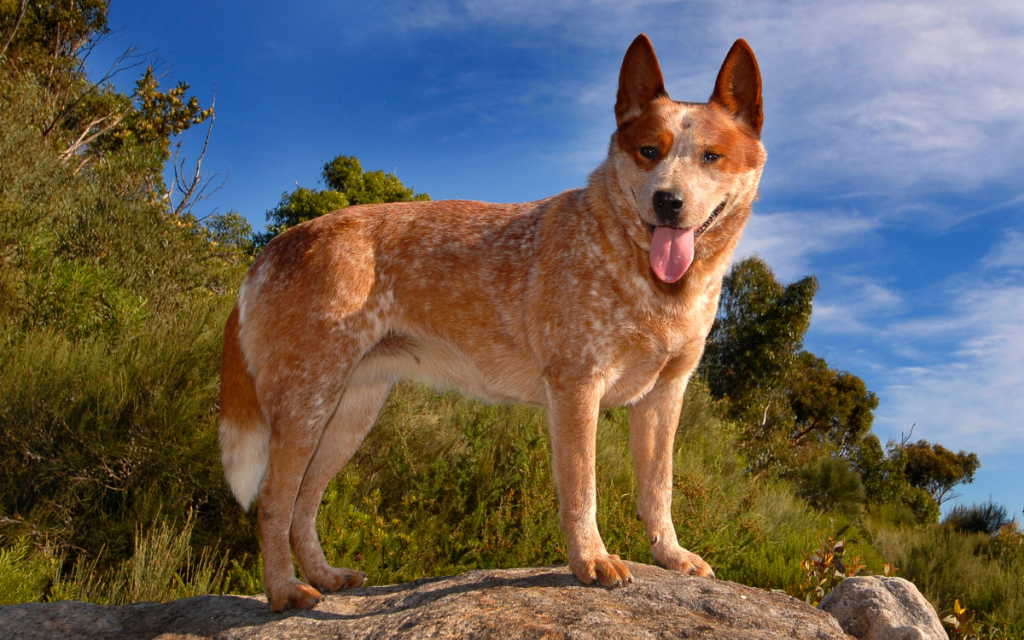

When your pup is relaxed in a safe environment, you’ll notice their entire body and tail are loose and comfortable—not stiff. They’ll stand confidently tall like they’re runnin’ the show, without lurching forward or backward. You might see their tail hanging loosely (not tucked under them), or swooshing gently, side to side. Depending on their body temperature, they may have their mouth closed with loose, relaxed lips, or open with that goofy tongue hanging out.
Body: Standing tall, loose
Ears: Loose and relaxed (not held tightly against head)
Tail: Hanging loose or gently wagging/swaying
Mouth: Relaxed lips with mouth closed, or open with tongue hanging
Eyes: Soft, blinking
Attentive/Interested Posture
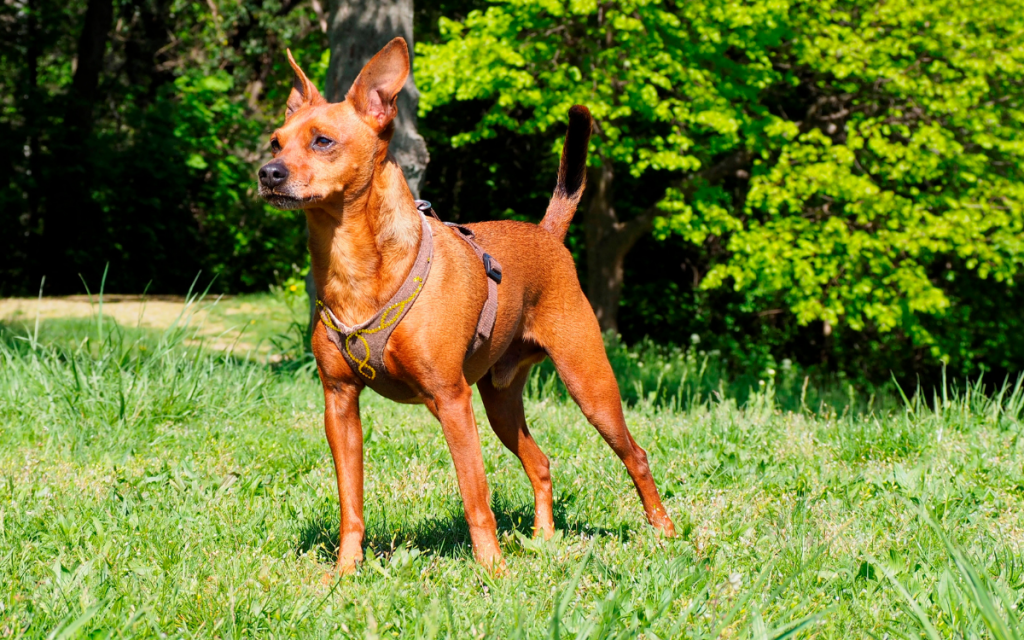

When your pup is interested in something around them (Squirrel!!) you’ll notice their body weight lean forward, their ears will be pricked up or stiffened, and they’ll hold their tail high1. This means they’re interested in their environment and waiting to decide how to react—playfully, fearfully, or aggressively1. They may hold their tail still if they’re in curiosity-mode—like trying to figure out what just moved in the bush—or they may be wagging it quickly side to side, if say, they’re excitedly waiting to pounce on a squirrel, or for you to throw their favorite toy.
Body: Tall, leaning slightly forward
Ears: Pricked or stiffened at the base
Tail: Held high. May be still or wagging rapidly
Mouth: Closed with slightly tight lips, or open with panting tongue
Eyes: Staring, wide
Playful Posture
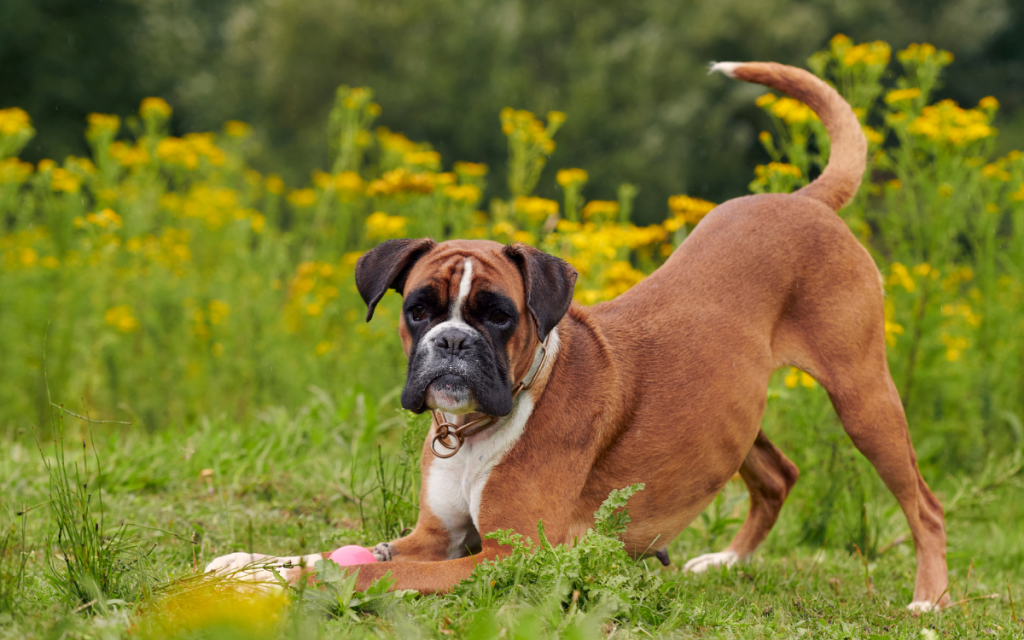

One of the most easily recognizable signals of playfulness is the “play bow” or “downward dog”, where dogs lower the front of their body and stick their booty in the air. It’s also a way for a dog to approach another in a non-threatening way1. You’ve probably seen your dog do this when they’re playing with you or another dog. Other signs they use to tell you they want to play include: pawing with their front feet, jumping while twisting, open-mouth panting (may be accompanied by staring at you, then not-so-subtly glancing at a toy), playful growling, light playful biting, and tail wags that are loose and relaxed1.
Body: Head and front paws down low, butt in the air. Possibly jumping and twisting
Ears: Often held backward
Tail: Held high but loose, possibly wagging
Mouth: Open-mouth panting, or closed with relaxed lips. May be biting lightly and playfully if directly interacting with another dog already.
Appeasement Posture
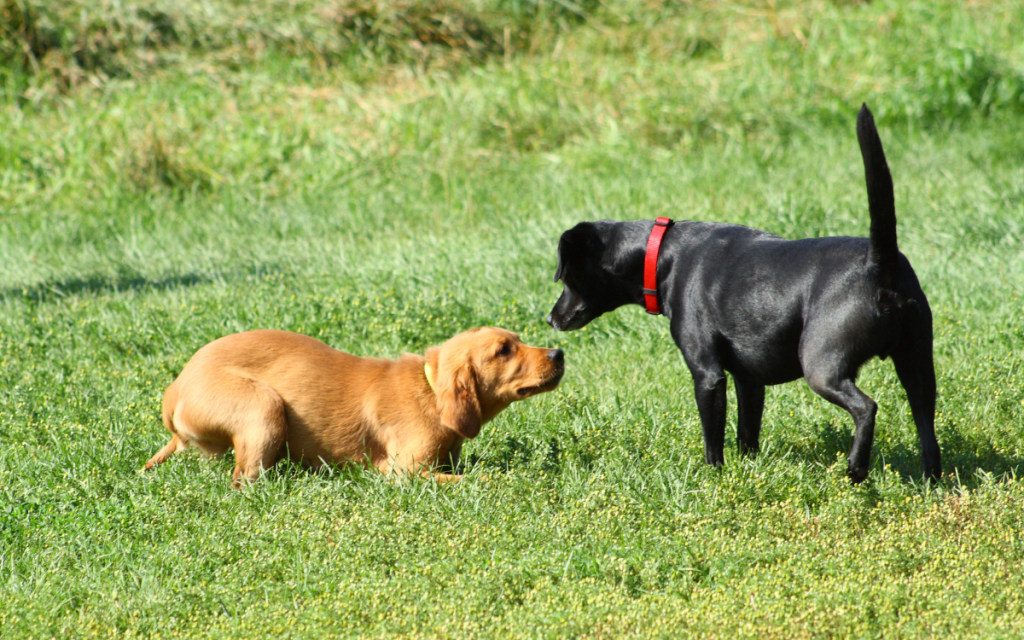

Appeasement is a way for your dog to say, “I’m not a threat! I come in peace!”. These behaviors can be used to greet dogs or humans who have a more dominant social status1. Appeasement postures can look similar to fearful and anxious body language—body low to the ground, ears low or tight against their head, tail stiff, low and wagging rapidly1. They may even roll over, lick muzzles, or pee1. It’s important to look at the full context of the situation to tell the difference between appeasement and fear.
Body: Low to ground or rolled over, exposing belly.
Ears: Low and close to body. Stiff.
Tail: Low or between legs. Stiff. Possibly wagging rapidly.
Mouth: Tight lips. May start licking.
Fearful/Anxious Posture
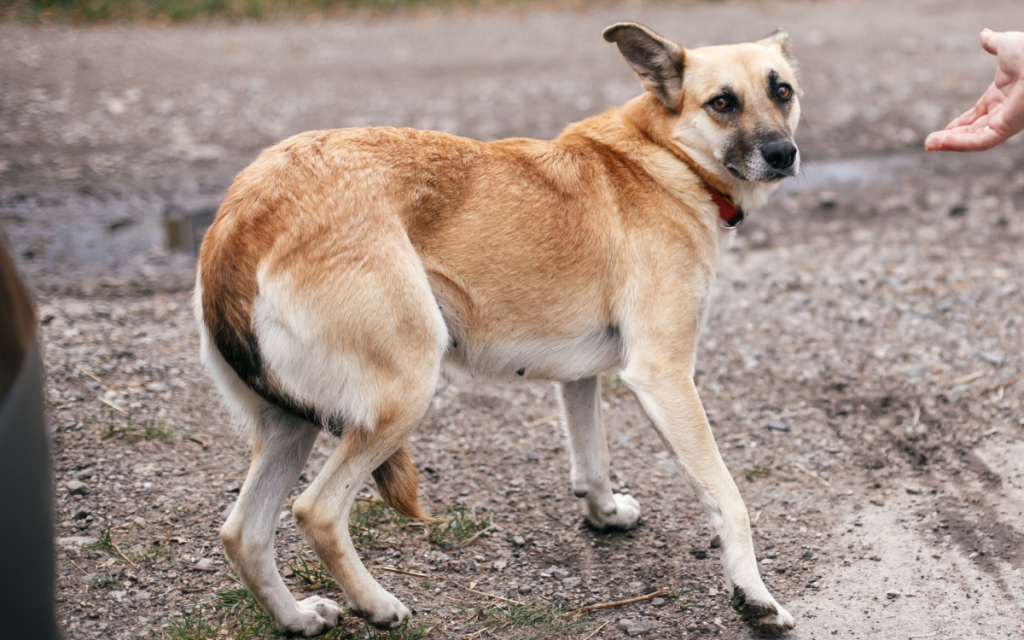

When your dog is afraid or anxious they’ll keep their body lower to the ground, either with their weight shifted backward, away from the threat1, or curling inward like a ball. They’ll hold their ears back, tucked tightly against their head, and hold their tail tightly down low or between their legs—possibly wagging with short, rapid wags1. In some situations they may raise their hackles (a.k.a. the fur on back and neck)1, cower, shiver, tremble, shake, pace, or even pee a little bit.
Body: Low to ground. Weight shifted backward. May raise hackles or tremble. Possibly freezing in place or pacing.
Ears: Held stiff and tight against head
Tail: Down low or between legs. Possibly short, rapid wags.
Mouth: Tight lips.
Eyes: Avoiding eye contact or “whale eyes” (when you can see the whites of their eyes)
Offensive Aggression Posture
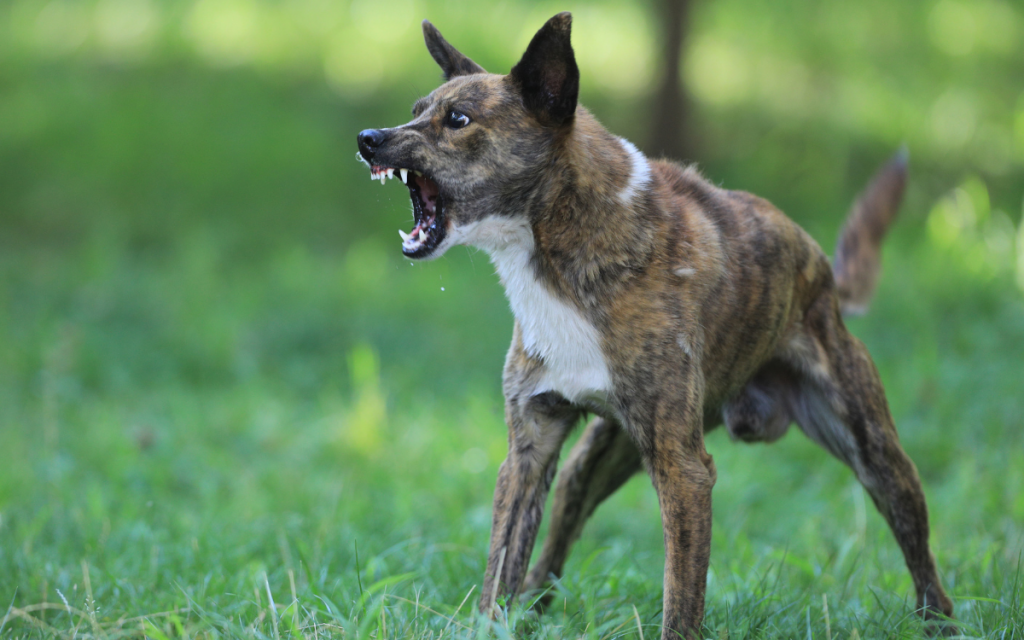

Aggressive body language changes depending whether the dog is on the offensive or defensive end of the situation. An offensively aggressive dog will stand tall, both ears and tail will be up, their hackles might be up, and they’ll raise their lips, but only expose their front teeth—incisors (stubby front teeth) and canine teeth (vampire-looking teeth)1. They’ll likely be making direct eye contact along with barking or deep growling that says, “Get off my lawn!”
Body: Standing tall, stiff.
Ears: Stiff, pricked up.
Tail: Held high.
Mouth: Raised lips, exposing just front teeth.
Eyes: Direct eye contact
Defensive Aggression Posture
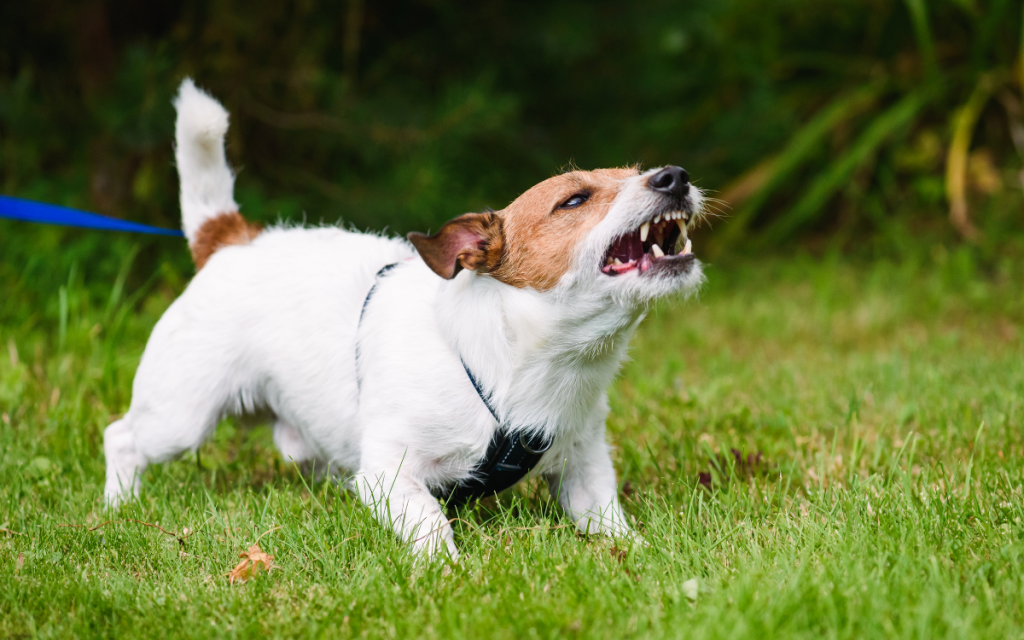

Opposite of offensive aggression, a dog who is being defensive will lower their body, shift their weight backward, possibly raise their hackles, raise their lips with the corners backward and expose ALL their teeth—as opposed to only incisors and canines1. They’ll likely avoid direct eye contact as they give clear warnings with deep barks or growls. This happens when a dog feels threatened and tries to protect itself. It can be a common posture with dogs rescued from abusive or traumatizing situations.
Body: Low to ground, weight shifted backward
Ears: Stiff, tight against head.
Tail: Held high.
Mouth: Lips tight, exposing all teeth.
Eyes: Avoid eye contact
Pain Postures


A dog in pain can be harder to recognize than you may think, and not all dogs show pain in the same way. With the exception of obvious injuries like a wound or broken leg that causes your dog to yelp or limp, many postures that indicate your dog is in pain can be easier to miss. For instance, a dog with arthritis or other hidden pains may lick a limb excessively, do full-body shakes when they’re not wet, pace around at night, or yawn excessively when they’re not tired. If your dog avoids your touch or starts guarding a specific part of their body, this is a red flag as well.
The biggest indicator that something may be wrong is when your dog suddenly exhibits a new or unusual habit, or acts out of character—like a friendly, loving dog suddenly growling and biting.
Body: Possibly hunched or stiff, limping, pacing, reluctant to move, trembling, scratching excessively, protecting a body part, shaking off when not wet
Facial expressions: Grimaces, glazed and wide eyes, flattened ears
Mouth: Excessive licking, panting (when not hot or active), biting, excessive yawning (when not tired)
Habits: New habits; out of character behavior; changes in eating, sleeping or drinking; hiding; suddenly seeking or avoiding attention, pawing at face, hopping up stairs two legs at a time, or avoiding stairs altogether.
Facial Expressions
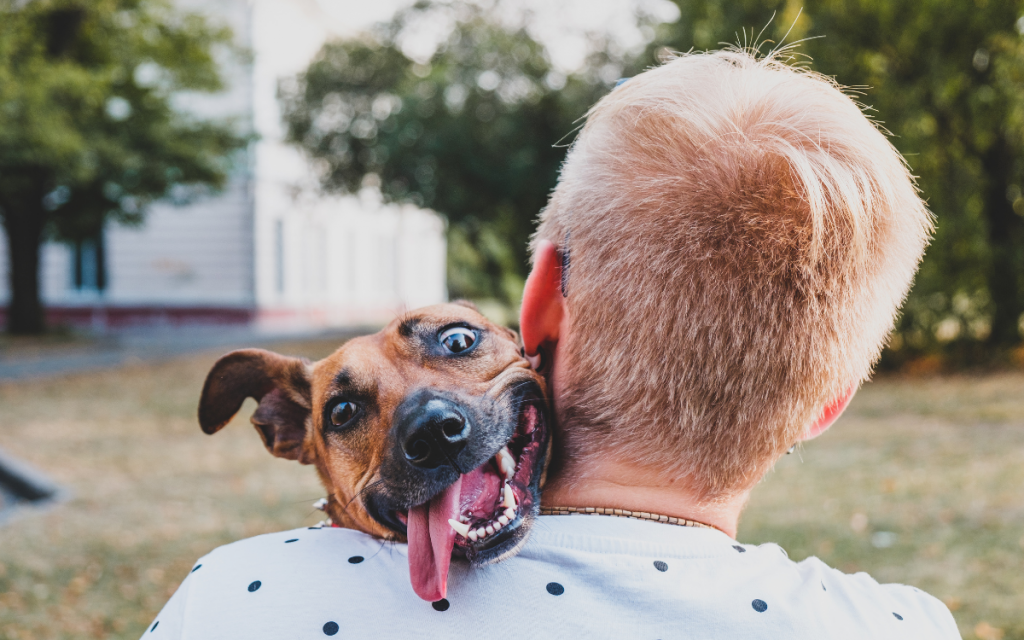

Eyes
There’s at least one look that most all pet parents easily recognize—the puppy dog eyes. Dogs really know how to pull at your heart strings when they’re begging. They just throw one of these “🥺” looks at you, and suddenly you’re handing over all of your cheese. Those eyes can hold a lot of meaning. Here are some other looks to pay attention to:
- Direct Eye Contact: When a dog makes direct eye contact with a new human or another dog, it can mean they’re on high alert and may possibly become aggressive1. In a trusting relationship, your dog may also stare or make direct eye contact with you, but in this case, it would mean your dog feels comfortable with you and loves you1! Aww googly eyes!
- Avoiding Eye Contact: If a dog is avoiding eye contact they’re likely feeling anxious, afraid, or trying to convey that they’re not a threat1.
- “Whale Eyes”: Whale eyes is a term used when you can see the whites of a dog’s eyes. Dogs exhibiting “whale eyes” are usually feeling overly stressed, scared or anxious1. Keep in mind that this look can be harder to see with certain breeds—like flat-faced breeds.
Ears
It may surprise you to learn that your dog’s ears are actually one of their most expressive features. Ears can tell you a lot about how your dog is feeling.
- Pricked Up/Raised At Base: If your dog’s ears are pricked up—or raised at the base for floppy-eared dogs—it means your dog is paying attention or interested in something1. You’ve probably noticed this when you use the word “treat” or “walk”, and their ears lift up at the base. A dog with pricked ears may also become excited or aggressive, depending on the situation.
- Held Back Or Tight Against Head: When you see your dog hold their ears backward and tight against their head, it’s an obvious sign that your dog is either feeling scared, anxious, trying to appease you or another dog, or they’re about to become aggressive if the threat increases1. Let’s just say there are way too many videos floating around the Internet with humans ignoring this clear sign saying, “I’m very uncomfortable right now!”
Mouth
With very few exceptions (a dog trained to “smile” as a trick, a breed that exhibits “submissive smiling” as an appeasement or happy greeting3, 4), any dog showing their teeth is a glaring warning sign to back off. However, there’s so much more to learn from what your dog is doing with their mouth, lips, and teeth.
- Tight/Stiff Lips: Even when your dog has their mouth closed, their lips can hint at how they’re feeling. If you see your dog holding their lips tight and stiff (along with other body language) it’s likely a sign they’re feeling scared, anxious, or may increase to aggression.
- Showing Front Teeth: When a dog shows only their front teeth (incisors and canines) it can mean a few different things. It can indicate that they’re scared/anxious, showing signs of offensive aggression, but it can also be more benign: although it sounds counterintuitive, when a dog greets a more dominant dog, they may show their front teeth as a sign of appeasement1. It can be difficult to tell the difference between a dog showing appeasement or one who is scared/anxious, so always take caution if you see a dog displaying their teeth.
- Showing All Teeth: This one is pretty obvious. A dog showing all of their teeth—including side and back teeth—is a clear sign of aggression1. It’s a warning that a bite is coming if the threat doesn’t back down. Often (but not always) accompanied by growling.
- Licking: In this case, we’re talking about licking when food isn’t present. Licking another dog’s muzzle or a human’s face is a dog’s way of saying, “Hey, I’m friendly. No threat here1!” Other times, excessive licking can be a sign of fear, stress, or even pain. Remember, licking lips is NOT a sign your dog is looking for face kisses.
- Yawning: Yawning doesn’t always mean your dog is tired. Dogs also yawn when they’re feeling scared, anxious, or even when they’re in pain.
Tail Wagging
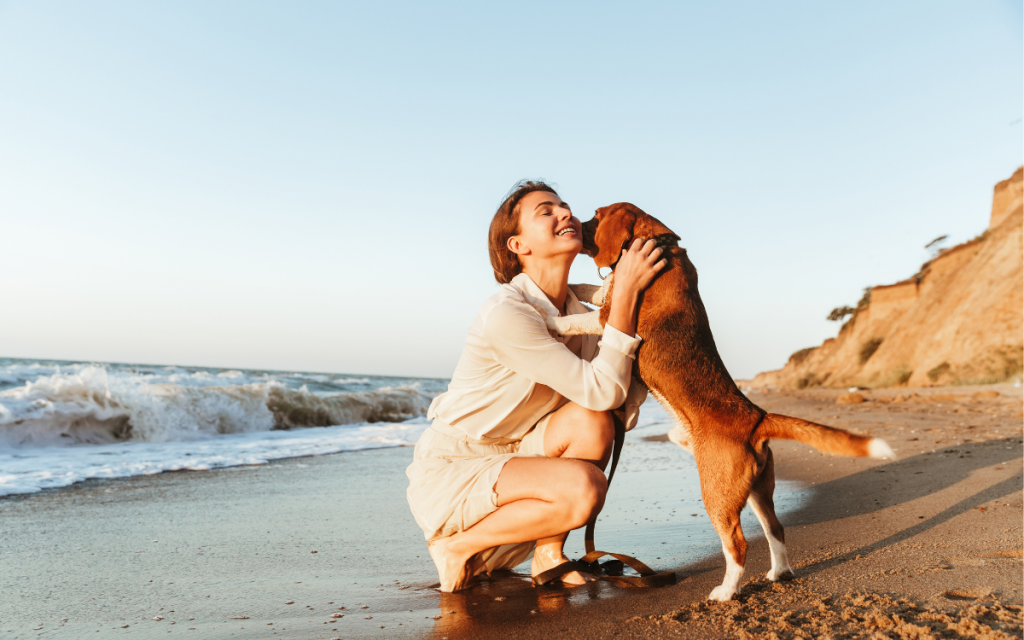

One of the biggest mistakes humans make with dog body language is assuming that a wagging tail is a happy tail. This is actually far from the truth! Different types of wags help convey different emotions and intentions.
Key Elements To Pay Attention To When Reading Tail Wags:
- Location: Where is dog holding their tail? High, low, straight out, between legs?
- Speed: How fast is the wag? Slow and methodic, slow and relaxed, fast, nearly vibrating?
- Breadth/Distance: Are they wagging with short strokes or broad/wide strokes? Is the tail being held stiffly or relaxed?
- Other Body Language Signals: What is the rest of their body language saying?
- Situation: Are they in a comfortable situation, or are they in a new/stressful situation?
In general, when a dog holds its tail stiff and high while wagging it with small amplitude, this shows the dog is highly aroused—not sexually aroused, more like “I-see-a-squirrel” aroused or “you-might-be-a-threat” aroused. Depending on the situation, they could become aggressive when you see this tail wag1. Keep in mind, that some breeds—like huskies and shiba inus—naturally carry their tails high or over their backs. This doesn’t necessarily indicate arousal or aggression, so it’s important to pay attention to other body language and the overall context of the situation.
When you see a dog holding their tail low or between their legs, stiff, and wagging rapidly with small amplitude, they’re showing signs that they’re either scared, anxious, or showing appeasement1. If the dog feels increasingly threatened in this situation, this type of wag can turn into aggression.
Lastly, the happy tail we all want to see from our pups is going to be loose and relaxed while wagging with large amplitude1—those big swooshes from side to side that sometimes turn into a whole-butt wiggle.
Since it’s pretty difficult to learn how to interpret tail wags from text alone, check out this video below to help differentiate tail wags:
Vocal Communication
Dogs have different sounding barks, growls and whimpers for different situations. Once again, reading overall body language and facial expressions can help you distinguish what these vocalizations mean. Just like parents often learn their baby has a different sounding cry when they’re hungry vs. when they need a diaper change, pet parents also can learn to decipher between their dog’s different barks.
- Barks: Dogs use barks as a warning, as a greeting to say hello, in defense, during play, to get attention1, or just to make sure you saw that cat crossing the yard.
- Growls: Dogs use growls as a warning, to signal a threat, or during play1. Aggressive growls are usually lower in pitch with longer duration between breaths.
- Howls: Not all dogs howl, but those who do (most notably huskies and malamutes) use howls to locate members of their group, to get attention, to alert others of danger, as a way to chat or sing with other dogs, or as a natural response to high-pitched noises like ambulances.
- Grunts: Grunts can be used as a greeting, as a sign of contentment1, or when they lazily plunk down on the floor to exaggerate how tough it is to be cute and sit around all day.
- Whimpers/Whines: Whimpers are usually used when a dog is in pain, to show submission, as a greeting, in defense, or to get attention1 (like when they really want you to share a piece of that bacon).
This article has been reviewed by Margo Hennet, DVM.
Margo Hennet, DVM, cVMA, and veterinarian at BARK is a canine nutrition, health, & wellness connoisseur. She has a combined 10 years of experience in clinical medicine, research, and education—that’s 70 dog years of know-how—and graduated from Colorado State University as a Doctor of Veterinary Medicine. She completed specialized training in internal medicine prior to working as a general practitioner in Colorado, has authored peer-reviewed publications and textbook chapters, holds certification in veterinary medical acupuncture, and is a member of the American Academy of Veterinary Nutrition and American Veterinary Medical Association.
Sources:
1 Luescher, A. U. (2017). Canine behavior and development. Canine and Feline Behavior for Veterinary Technicians and Nurses, 30–50.doi:10.1002/9781119421412.ch2
2 Ciribassi, John. “Canine Body Language: But What Do You Really Mean? .” Fetch DVM 360, Chicagoland Veterinary Behavior Consultants, https://www.fetchdvm360.com/wp-content/uploads/2017/11/FetchSD-2017-0014-0052-Behavior.pdf.
3 Gibeault, Stephanie. “How To Read Dog Body Language”. American Kennel Club, https://www.akc.org/expert-advice/advice/how-to-read-dog-body-language/
4 “What Is Submissive Smiling In Dogs?”. Michelson Found Animals, https://www.foundanimals.org/submissive-smiling-dogs/

